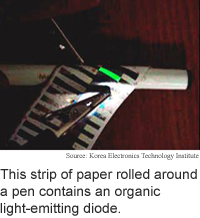
Paper promises better e-paper
It is clear that computer displays will
someday be thin and flexible enough to roll up, enabled by plastic electronics.
Most prototypes to date have been built using organic light emitting
diodes (OLED) on plastic or metal foil substrates. Researchers from Korea
Electronics Technology Institute (KETI) have produced electronic paper
made from ordinary paper coated with thin layers of plastic electronics.
Paper has the advantage of being light, inexpensive and thermally
and mechanically stable during processing. Their method could be used
to make roll-up displays of all types, including electronic paper, electronic
maps, and advertising displays.
The researchers made the device by coating a sheet of commercial
inkjet paper with the plastic parylene to protect the paper from moisture
and provide a uniform surface, then applying a second layer of parylene
followed by layers of nickel, three types of organic material and a metal
top layer.
The top layer is semi-transparent, transmitting more than 75 percent
of the light generated beneath it to provide a maximum brightness of 417
candelas per square meter. Computer display brightness values typically
range from 150 to 2,000 candelas per square meter.
The prototype device has emitting areas of 10 millimeters by 2
millimeters. The device worked while rolled around a pen with a diameter
of 8 millimeters, according to the researchers.
The researchers presented the work at the Society for Information
Display (SID) International Symposium in Seattle Washington, May 23 to
28.
Software fuse shorts bugs
Holograms enable pocket projectors
Memory cards make connections
Interface blends screen and video
Briefs:
Paper promises better e-paper
Birds-eye view helps guide public
Nanotubes boost neuron growth
Chip protects single atoms
Mega video enables virtual window
Method tests molecular devices

Research Watch blog
View from the High Ground Q&A
How It Works
RSS Feeds:
News
Ad links:
Buy an ad link
Ad links: Clear History
Buy an ad link
|
TRN
Newswire and Headline Feeds for Web sites
|
© Copyright Technology Research News, LLC 2000-2010. All rights reserved.